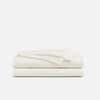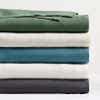Linen Versus Cotton Sheets: What’s to Love (and Not) About Both Natural Fibers
One conveys laid-back luxury, and the other is famously soft.
Published May 6, 2022 1:00 AM
We may earn revenue from the products available on this page and participate in affiliate programs.
All sheet sets made from natural fibers are not created equal: Look no further than this linen versus cotton sheets breakdown for proof. Both plant-derived options are great—one is known for being laid-back but luxurious; the other has a famously soft feel—but they offer completely different sleep experiences. For details on the composition and pros and cons of each, we tapped a trio of pros: Rosie Osmun, EachNight and Amerisleep contributor and a certified sleep science coach; Annie Kersey, the lead interior designer at Purple Cherry Architects; and Mary Graham and Nicole Salvesen of design studio Salvesen Graham. Read on for their thoughts on each style.
Looking for a new sheet set to love? Search these Domino faves:
What Are Linen Sheets, Really?
Let’s start on the farm: Flax is a flowering annual that gives us not only bed linens but the wellness favorite flaxseed. Linen sheets are made from the plant’s stalks. The textile generally has a rigid, heavy feel because flax fibers are less flexible than wool or cotton ones. And don’t let their low thread count deter you: Because the thickness of flax fibers makes them more difficult to weave, the ideal range is between 80 and 120. In this case, more thread results in a bulkier, less breathable fabric, and no one wants that.
The Pros and Cons of Linen Sheets
Linen sheet sets excel at heat and moisture absorption, and Graham and Salvesen appreciate that the fabric softens with every wash and holds its shape better than cotton. The material is super-durable, too: Cellulose fibers in linen yarn are longer and wrapped tighter than those in cotton yarn, which gives it more strength and longevity, explains Osmun. The bonuses are aplenty: Linen sheets are bacteria-resistant due to the fabric’s exceptional filtering properties (no dust mites or fungus allowed); shed dust and dirt more efficiently than other options made of natural fibers; and are naturally anti-static, hypoallergenic, and eco-friendly (flax is a renewable resource that requires minimal pesticides and irrigation to grow).
Bear in mind, though, the rough texture of flax fibers gives brand-new linen sheets a stiff feel that takes getting used to. “Linen is wrinkle-prone and has a coarse, stonewashed feel compared to cotton, which is softer to the touch and more textured and polished,” says Kersey. While linen does typically soften over time, cotton has that supple texture immediately. If you’re good with the wrinkled, laid-back look, linen sheets are super low-maintenance. Machine-wash them with a mild detergent in cold water (go warmer for stain removal) and dry on a gentle setting. Finally, linen sheets can cost more than regular cotton sheets because the fiber is pricey and difficult to harvest, Osmun points out, but the expense is worth it if you value long-lasting bedding.
Who Should Sleep on Linen Sheets
If you prefer wrapping up in more substantial sheets, go for linen, recommends Kersey. Graham and Salvesen also point out that linen’s temperature-regulating properties make it a solid pick for hot sleepers.
What Are Cotton Sheets, Really?
Fun fact: The term cotton sheets encompasses multiple varieties, but they’re all harvested the same. The fluffy fibers are found within the seeds of the cotton plant and are then woven into yarn. The material can come from three varieties of cotton: pima or Supima, Egyptian, and Upland, the latter of which is used most often. Some textiles contain polyester fibers as well, Osmun says, so pay attention to the fine print on product labels.
Cotton sheets also come in a couple of weave types: crisp percale, which has a tightly woven, crisscross yarn formation, and sateen, a smooth, shiny combination of satin and cotton that is considered the more luxurious of the two. Additionally, yarn length—also known as staple—can determine the durability of cotton sheets, Osmun notes. Linens with long or extra-long staple tend to be sturdier.
And heads-up, eco-friendly enthusiasts: Organic cotton sheets are free of harsh dyes, metal-filled colorants, or chemicals such as stain-repellents and formaldehyde.
The Pros and Cons of Cotton Sheets
Cotton sheets are classic for a reason: The breathable material is suitable for year-round use. Cotton fibers naturally pull heat and sweat away from the body, plus the material’s inexpensive price tag is a draw for anyone who can’t resist a seasonal bedroom refresh. Throw in a patterned sheet set and you’ll have a bed that’s casual but still chic. (Graham and Salvesen suggest the highest thread count to up comfort and longevity.)
Here’s another perk: Cotton is a breeze to clean. We recommend machine washing on a delicate setting with cold to warm water, mild detergent, and no bleach, then drying on a low or medium heat setting to minimize shrinkage and pilling.
Who Should Sleep on Cotton Sheets
Like the feeling of smooth sheets against your skin? Cotton bedding is the move for you. The same goes if laundry is your least favorite chore, as this option is the lower maintenance of the pair.





